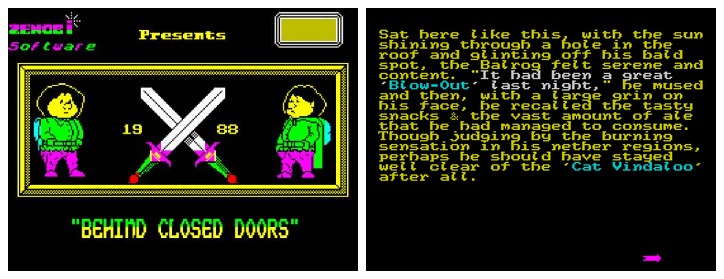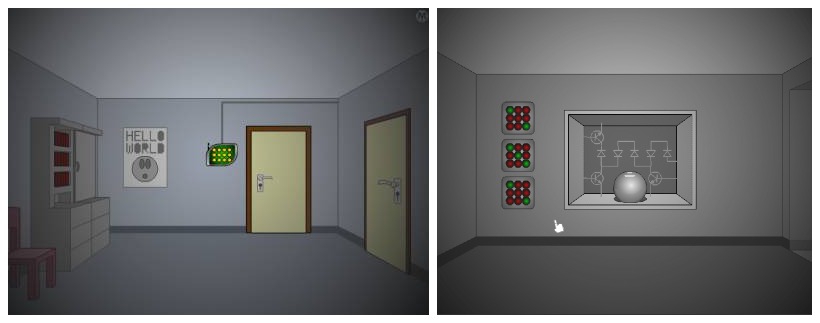Escape games: searching objects, clues, relating them, and solving puzzles to exit a room or achieving a goal and escaping… You probably thought about how well it is designed as to be so fascinating and addictive. But, did it simply come to somebody’s mind all of a sudden? How did everything begin?
A lot of articles about the origin of escape rooms can be found in blogs, escape room companies websites and dissertations. The content is diverse and generally confusing. In this post, we will try to present it in an organized and clear way.
So, to begin with, something sure is that the detective fiction and certain genres of videogames have been what gave rise to live games, which will then evolve into the escape rooms as we know them nowadays.
Detective fiction
Although its origins are placed around 1840, texts with more than 2000 years and a very similar style have been found. However, it is at the end of the 19th century and the beginning of the 20th century when the detective fiction bursts into, with authors like Sir Arthur Conan Doyle (creator of the famous character Sherlock Holmes) or Agatha Christie. This genre focuses on characters who find and relate clues, items and testimonies to solve mysteries… It sounds familiar, doesn’t it? Furthermore, we’ll see how this was of maximum importance for the birth and development of escape rooms.
Videogames
They were born in the 50s. Their history is as long as interesting and covers genres that were, sometimes indirectly and other times very directly, forerunners of escape rooms.
In 1988 a British videogames developer launched Behind Closed Doors, a game belonging to the text adventures genre. This type of games was based on text only. The text was telling a story to interact with through commands (such as “examine wall”, “grab item” or “open door”) in order to progress in the game. In this case, the goal was escaping a room. Text adventures were born long before (in the 60s), but it was thanks to games like this one that they became really popular, although during a short period (1988-1992).

Concurrently, at the end of the 80s, graphic adventures began to develop. This genre became very popular since the very beginning, its popularity lasting until our days. In these games, we control one or more characters to examine places, use and combine items, solve logical puzzles, obtain information by interacting with other characters, and relate clues to progress in the game and achieve the final goal (these mechanics sound familiar, right?). Lucas Arts (a videogames developer founded by the creator of Star Wars and Indiana Jones) was the leader of the golden age, with titles that went down in the history of graphic adventures and videogames themselves, besides being direct forerunners of our escape rooms. You’ve probably heard about Maniac Mansion (1987) or The Secret of Monkey Island (1990) (you can play them in a PC or a smartphone with the emulator SCUMMVM; you can download the ROMs here). Their link with escape rooms is so strong that some of the current best rooms are inspired in or directly based on these graphic adventures.

Later, with the spread of Internet, the browser games appeared. In order to be playable in any computer with a browser and Internet connection, they needed to be light, with little graphic and processor requirements, short and intuitive. These limitations led to the proliferation of games that left the dialogues and the depth of the plot (fairly elaborate in the graphic adventures) behind, with the purpose of focusing almost exclusively on searching and using items, figuring out codes and solving logical puzzles to reach the next level (where more puzzles awaited). Despite the simplicity of graphics and plot, some of them turned out to be extremely entertaining, as the popular Mystery of Time and Space (2001).

The genre kept on evolving and finally we saw the arrival of games whose goal was… exactly: escaping a room! The first one was Crimson Room (2005), in which we are in the shoes of someone who wakes up in a crimson room, with the only memory of having drunk the previous night, and needs to escape from it (you can play it for free here; in the case you play, have in mind that one of the clues leads to an inactive URL; the code in the URL should be “1994”).

Many other titles followed. With a large audience on both browsers and smartphones, escape room videogames were here to stay. But that wouldn’t be all… The evolution was about to come: the live escape games.
Live games
In 2006, in Silicon Valley (headquarters of companies like Google, Apple, Facebook, and innovation center where every start-up wants to be, south of San Francisco Bay, California), an IT group created a game inspired by the novels of Agatha Christie where, inside a room, the players had to solve an enigma in a limited time. It was much simpler and more rudimentary than the concept of escape room we are used to nowadays, but it was very successful. Curiously, its name was Origin.
Two years later, in 2008, in Japan, the screenwriter and director Takao Kato, with the background of Origin and inspired by the browser escape games, created the Real Escape Game. Very close to the escape rooms of today, it especially focused on solving logical enigmas. Its success made these games spread in Asia and reach in 2012 San Francisco, where also spread by the hand of Kazuya Iwata, a friend of Kato.
Attending to the gradual evolution of the phenomenon, it becomes a hard task to set a date and a place of birth of modern escape rooms. But, for many, that date is 2012 and that place is Budapest: Attila Gyurkovics opens the first escape room in Europe, by the franchise Parapark (that later would have presence in more than 20 European cities and Australia). Attila claims that he didn’t know anything about the Japanese escape games, and that he based the game on his experience as a professional personal trainer and on the theory of flow of the Hungarian psychologist Mihály Csíkszentmihályi. Due to this parallel development, the difference with the Japanese rooms is noticeable: while in Asia the main ingredient was the solution of logical enigmas, the European model focused more in making the players live an adventure.
But let’s stop for a moment on the “theory of flow”. Indeed, if we might reduce to the minimum the ingredients of today’s escape rooms, these will be the following three: detective fiction, videogames and… precisely: the theory of flow.
Theory of flow
For sure, you’ve experienced one of those moments in which you are so absorbed in and enjoying what you are doing that it’s not an effort, so focused on a task that you don’t think about anything else and time seems to fly. And, luckily, that was inside an escape room.
The flow is the mental state in which a person is fully immersed in an activity he/she is performing. It is characterized by a feeling of energy channeling, full involvement, and enjoyment during the activity. The concept was proposed by the psychologist Mihály Csíkszentmihályi in 1975. He described the components of a flow experience as follows:
- Clear and achievable goals. Knowing exactly what the goals are allows us to concentrate our effort in the right way.
- The activity is a challenge, which activates the motivation circuits.
- Concentration and focus. Namely, a high level of attention on a limited field, which optimizes the effort.
- Direct and immediate feedback. Successes and failures during the activity are obvious, hence the behavior can be modified as needed.
- Balance between skill level and challenge. The activity is neither too easy nor too hard, close to the limit of the skills and abilities set.
- Intrinsic reward of the activity, which is not a burden.
- Distortion of the temporal experience. The subjective perception of time is altered.
- There is a sensation of control over the situation or activity.
Attila was very successful considering this theory in his project. If you think about any high-quality escape room you’ve played, you’ll probably identify, one by one, every single point mentioned above.
Evolution and trend
Detective fiction and videogames gave rise to the first live escape games, which in turn, together with the theory of flow, gave rise to the escape room concept we are familiar with. But, what about the evolution of the latter since then?
Some paragraphs above we’ve seen how, during the process, graphic adventures evolved toward simplicity, sacrificing plot and dialog, in order to adapt to browser and mobile games (focused on search, items and puzzles). The first escape rooms derive from them. Later, with the phenomenon development and a very interested audience, competitiveness and demand made them to step forward, incorporating deep plots and dialogues (by texts, audios or real dialogues with actors) that graphic adventures had lost on the way. Nowadays, what the best escape rooms aim to offer is the experience of an elaborated adventure, as immersive as possible, with a decoration that isolates from reality and puzzles always integrated in the plot, providing a flow experience in a context the closest to living a movie or a videogame.
Current scene
Due to the huge success from the beginning, the escape rooms quickly spread. In 2013 they arrived in Spain, in the city of Barcelona, by the previously mentioned Parapark. Currently Spain has more than 1.500 rooms. Growth occurred not only in Spain or Europe: by 2017 there were already more than 8.000 escape rooms all around the world.
Today it’s uncommon that a young or middle-aged person doesn’t know what an escape room is. Most young people have played at least once. It is a first-line activity in companies events and bachelor parties. Many players develop a great passion that justifies travelling to other cities or countries to play, giving rise to a new type of tourism. Some of these players write in blogs or create their own escape room, contributing to the expansion of the phenomenon.
As time goes by, rooms that are outdated close to reinvent themselves. Innovation is non-stop: hall escapes develop to host large groups or be transported and played everywhere, competitive escape rooms appear, as well as rooms for one or two players, some companies hazard outdoor escape rooms, escape room board games are sold to play at home, escape books (namely, books simulating an escape room) are published, and escape rooms in virtual reality are experimented. Discovery’s Science Channel itself produced a contest with series format, Race to Escape, in which escape room teams compete. Escape rooms are even the main topic in several Hollywood movies and theater plays.
Escape rooms expansion is booming. The future is promising and, luckily, we will be there to tell you about it. But the present (we’re already writing about it) is also promising: nowadays, the best escape rooms can provide really memorable experiences. We say that history helps to understand better the present, and this to enjoy it more. So… we wish the history in this post may help your experiences to be even more memorable!
